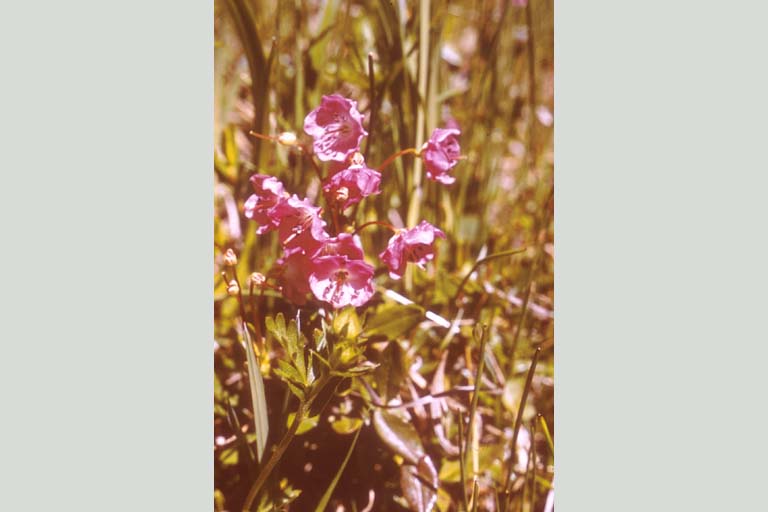Plant Data Sheet
Species:
Bog Laurel, Kalmia microphylla

photo
credit: UW Library Digital Collection, Plants of Western Washington Collection
http://content.lib.washington.edu/pww/plants-copyright.html
Range:
Southern
Alaska to California, east to Alberta and Colorado
(Evans et al, 2001)
Climate, elevation:
Tundra
and boreal climates, low elevation in Washington (Cooke,
1997),
high elevation in Colorado (Evans
et al, 2001)
Local occurrence:
Somewhat
uncommon due to reduction of habitat. Found west of Cascades
(Cooke, 1997)
Habitat preferences:
Sphagnum
bogs and fens (Cooke,
1997)
Wet to very
wet soil, low in nitrogen, shade
intolerant (Klinka
et al, 1995)
Plant strategy type/successional stage:
Stress
tolerator, later
succession (undisturbed bogs)
Associated species:
Ledum
groenlandicum, Vaccinium oxycoccus, Sphagnum sp.
(Cooke,
1997)
May
be collected as:
Seed
(Baskin and Baskin, 1998)
Hardwood
cuttings (Evans et al, 2001)
Collection restrictions or
guidelines:
Flowers
May through September
(Cooke,
1997)
Seed germination:
71-112
day cold stratification has been used (Baskin and Baskin, 1998)
also
found to be non dormant and germinate at 22° C
(Baskin
and Baskin, 2002)
Seed life:
not
found
Recommended seed storage conditions:
not
found
Propagation recommendations:
The following
protocol for cuttings is from, Evans
et al, (2001) working
in Montana:
Hardwood
cuttings are collected in early September
Cutting
length, 6 cm heel or mallet cutting
Cuttings
kept moist and cool prior to treatment
Cuttings
treated with 4000 ppm liquid IBA (could try 8000 to 10,000 PPM and double-wounding
base of cuttings),
mist,
and 22°C bottom heat in 50% peat, 50% perlite media in greenhouse.
Misted
once a day, but high humidity chamber would be the preferred system
Cuttings
grown for 4-5 months
Transplanted
to 800 ml (4.5 inch) pots in spring, but don't fill-out pots until fall of
second year
~20%
rooting
Soil or medium
requirements:
50:50 Peat: Perlite (Evans
et al, 2001)
Installation form:
800 ml (4.5 inch) container
Recommended planting density:
Care requirements after installed:
Normal
rate of growth or spread; lifespan:
Slow,
long-lived
Sources cited:
Baskin, Carol and
J.M. Baskin
1998.
Seeds: Ecology, Biogeography
and Evolution in Dormancy and Germination, Table
10.30, Chapter
10: A Geographical Perspective on Germination Ecology: Temperate and Arctic
Zones. Academic Press, 666 p.
Baskin,
Carol. and Jerry M Baskin,
2002. Propagation protocol for production of container Kalmia microphylla
(Hook.) Heller plants; University of Kentucky, Lexington, Kentucky. In: Native
Plant Network. URL: http://www.nativeplantnetwork.org (accessed 12 May 2003).
Moscow (ID): University of Idaho, College of Natural Resources, Forest Research
Nursery.
Cooke,
Sarah Spear. 1997 A Field Guide to the Common Wetland Plants of Western Washington
& Northwestern Oregon. Seattle Audubon Society, Seattle, WA 415 p.
Evans,
Jeff; Wick, Dale; Luna, Tara. 2001. Propagation protocol for vegetative production
of container Kalmia microphylla (Hook) Heller plants (800 ml containers);
Glacier National Park, West Glacier, Montana. In: Native Plant Network. URL:
http://www.nativeplantnetwork.org (accessed 12 May 2003). Moscow (ID): University
of Idaho, College of Natural Resources, Forest Research Nursery.
Klinka,
K., V.J Krajina, A. Ceska, and A.M Scagel. 1995 Indicator Plants of Coastal
British Columbia. UBC Press
Vancouver B.C. 288p.
Data
compiled by:
Matthew
Ramsay, May 12, 2003
